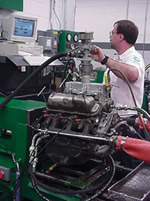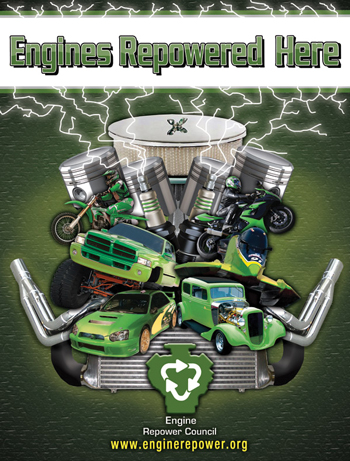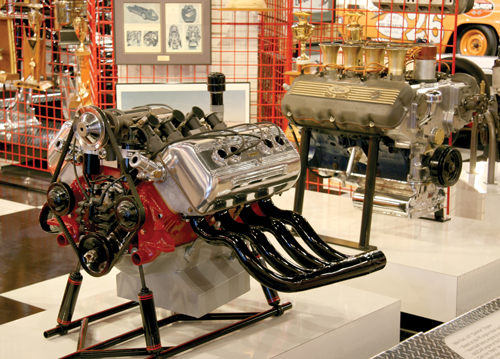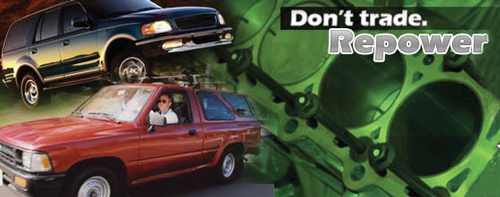

BENEFITS OF A REPOWERED ENGINE

It was among travelers' worst nightmares and a very expensive trip for this motorist. His beloved pickup blew the engine and had to be towed 250 miles home. The temperature gauge didn't work, nor did the check engine light. By the time he realized the engine was overheated the damage was done.
Exploring his choices, he and his technician considered the pros and cons of trading in the truck, having a new engine installed, overhauling the old engine or installing a remanufactured engine.
Trading in the truck, like "throwing the baby out with the bath water," was out. The costly option of a new engine was also out. How about overhauling the old one? Also expensive, said his mentor, possibly costing about the same as installing a remanufactured engine.
However, the remanufactured engine would carry a strong factory warranty. The remanufactured engine would not only be as good as the original, in several respects it would be better. Hand-built with the finest equipment available, these engines are built to more exacting standards than original. Further, a reman has the added benefit of a "seasoned" block, a metallurgical phenomenon which extends engine life and enhances performance.
Several lessons can be learned from this owner's experience and that of others who have "blown" their engines.
Lesson #1: Don't gamble with inoperative instruments and warning lights. The latter, when working properly, light up when the ignition first is turned on.
Lesson #2: At the first indication of overheating pull off the road and shut off the ignition. You may be able to avoid totally destroying your engine.
Lesson # 3: If, by failing lessons #1 and #2, you've ruined your engine, you have some viable options beyond disposing of your vehicle.

Your Choice Could Cost You Thousands
BETHESDA, MD – June 21, 2010 – When serious engine trouble hits, the Engine Repower Council (ERC) recommends that vehicle owners ask themselves if they should repower or replace the vehicle. The choice can result in a cost difference of thousands of dollars.
“If you had a serious plumbing problem would you repair your current plumbing or install all new plumbing? What if covering the cost of the new plumbing meant you had to apply for a loan that would take you years to pay off? What if your homeowner’s insurance rate would increase significantly if you bought the new plumbing? This may seem like an absurd scenario, but when engine trouble hits many vehicle owners don’t even consider repowering their engine instead of taking on the financial burden of buying a whole new car,” said Ken Carter, chairman of the Engine Repower Council.
Because many consumers don’t realize the financial benefits of engine repowering, the Engine Repower Council has created a cost comparison chart of popular vehicles to illustrate the cost difference between repowering and purchasing a new vehicle. For example, to replace a worn out engine with a remanufactured/rebuilt engine in a 1980 to 1995 full size V8 domestic pickup would cost $2,700 to $3,450 compared to an average cost of $30,000 to purchase a new vehicle.
“The cost savings is significant and that is without taking into account auto loan interest and increased insurance rates,” continued Carter. With repowering, a vehicle’s engine or an identical one from another like vehicle, is completely disassembled, cleaned, machined and remanufactured/rebuilt. Unlike used or junk yard engines with an unknown performance and maintenance history, repowered engines are dependable, reliable and backed by excellent warranty programs.
Vehicle System/Component Service Notes
Click image to enlarge.
What is an Engine Warranty?
Like most warranties, an engine warranty is a guarantee given to the purchaser by a company stating that the remanufactured/rebuilt engine is reliable and free from known defects and that the seller and/or manufacturer will repair or replace defective engine parts within a given time limit and under certain conditions.
It's important that you understand the term and extent of your engine warranty coverage. A typical engine warranty covers the remanufactured/rebuilt engine only, not related automotive parts, for a limited time and/or mileage.
Some engine warranties extend labor coverage which would typically reimburse a professional installer a specific dollar amount for fixing or replacing a warranted car engine. A few warranties may even cover towing charges and might provide you a rental car during a warranted engine repair. BUT, you'll have to keep a lookout for pitfalls such as warranties that have a deductible or don't go into effect for 90 days or don't pay mechanic labor charges.
The big question is... What is covered and for how long?

How to Shop for a Warranty?
1. ASK the engine rebuilder/remanufacturer or engine vendor or installer for a copy of their warranty
2. READ the fine print
3. LOOK for these key components:
4. ASK the engine vendor or engine installer to explain the warranty process. Asking specific questions will lead to a general concept of what each warranty would cover.
Q: A professional mechanic installed a remanufactured/rebuilt engine in my vehicle and after 100 days of operation there is excessive oil leaking. What should happen next?
(One Possible) A: You should deliver the vehicle back to your engine installer where they will analyze the problem and verify the source of the leakage. If the leak originates from the car engine and is considered excessive, and it's within the warranty period, the necessary engine repair will be made. The vehicle owner will not have to pay for replaced automotive parts or labor. However, you will be responsible for delivering the vehicle and for any fluids that will be lost during the automotive repair. The warranty does not cover transportation.
Note: Some warranties may cover 100% of the automotive repair and even offer a rental car while your car engine is repaired. Other warranties may have a deductible or a maximum labor cap.

Two examples of Ford V8s – a fuel-injected Flathead with an Ardun overhead-valve conversion, and a ’64 single-overhead cam 427ci big block.
A repowered engine is one that has been remanufactured to prescribed standards and specifications by highly skilled machinists using state-of-the-art equipment and components. During this process many new components are installed that meet or exceed original equipment performance standards. Frequently, repowered engines are better than the engines originally installed at the factory. They are dependable, reliable and backed by excellent warranty programs.

REMANUFACTURING: THE ORIGINAL RECYCLING
Ten or 15 years ago, auto technicians would rebuild hard parts for customers right in the shop. Today, that system doesn't work because consumers don't have time to wait and don't want to pay for the additional labor. Remanufacturing now solves these problems, and as such, it is one of the largest product categories in the automotive aftermarket. The entire remanufacturing industry generates approximately $65 billion in sales with the automotive segment representing $37 billion of that total.
"This industry is a balancing act, and the business itself is not glamorous," said Rick Andrulis, executive vice president of sales and marketing at Springfield Remanufacturing. "You never sacrifice quality for cost considerations so the margins are tight."
Remanufacturing begins with a greasy core that needs cleaning. This duty generally falls to entry level people who learn the business by doing the disassembly. Cores consist of hard parts such as engine blocks, crank shafts, valves, rod bearings and cam shafts. High wear components such as sleeves, gaskets and bearings are always replaced.
Cleaner, Better, Cheaper
Remanufacturers can correct product flaws that occur after the typical 50,000 mile OEM warranty expires. The cost for a remanufactured part is generally 30-50 percent of what a new part would cost, because labor, energy and raw materials are conserved. Bill Gager, president and CEO of the Automotive Parts Rebuilders Association, said remanufacturing uses between 80 and 85 percent less energy than producing a new part. Labor, machining, and raw materials are saved while chemical waste and energy consumption are drastically reduced all of which help keep operations lean.
"Much of the cost savings can be attributed to the fact that the price of initial tooling and development are not in the remanufactured unit," said Tony Perticari, vice president of sales and marketing at Crown Remanufacturing, Inc. "This is not to say that we do not tool up for parts which are not readily available in the aftermarket. We simply salvage a good deal of the core, and this keeps the cost down."
"The OEs don't give much credence to problems which are not large enough to cause a recall whereas the remanufacturing industry can address very specific, short run engineering flaws," said David Deegan, vice president at Engine Lab of Tampa, Inc. In fact, OEs frequently look to remanufacturer suppliers to solve reoccurring part failures.
"Besides the cost savings, many remanufactured parts carry extensive warranties to boost consumer confidence," Perticari said. "This business has been around for 50 to 60 years, and most of the major companies possess the same sophistication and QS/ISO certification as tier one suppliers."
Environmentally Friendly
The average car owner is unaware of the environmental benefits of a remanufactured part. "There is a whole green pitch that the remanufacturing sector has overlooked for years. Consumers want eco-friendly products, and there's data showing that green companies grow faster than their competitors," said Michael Cardone, Jr., president & CEO of Cardone Industries, Inc.
"While it's difficult to get people to spend money on recycling, it's easy to sell remanufactured goods because the cost is lower. People don't realize that they're spending on recycling," Deegan said.
The cost for a remanufactured part is generally 30-50 percent of what a new part would cost, because labor, energy and raw materials are conserved.
Consumer Education
The Automotive Repower Council is in the process of developing a national campaign to educate consumers about remanufacturing. By gathering feedback from consumer focus groups and distributors and installers, they hope to devise a message that will help consumers understand the value of remanufactured parts.
"The industry is under a shade tree when it comes to consumer awareness. I don't think most consumers realize how much of a remanufactured part is actually new. By the same token, many consumers will think they're getting a brand new engine when in fact, they are buying remanufactured," Andrulis said. Up to 90 percent of the replacement engines, transmissions, CV joints, starters, rack and pinion units, brakes, and alternators available on the market are remanufactured.

Legislative Challenges
New parts are installed on new vehicles, where they eventually fail due to normal wear and tear or design weaknesses. The cores then go to a remanufacturer who rebuilds the part and puts it back on a vehicle. This can go on in perpetuity unless the cycle is interrupted.
The vehicle scrappage provision in the Energy Policy Act of 2002 (S.517) recently defeated by the Senate would have threatened this cycle. The act authorized federal grants to state programs that provide monetary incentives for motorists to scrap vehicles 15 years old and older. This legislation would have hurt the industry on many levels, from taking cores out of circulation to eliminating the aftermarket's prime customer base of older vehicles.
"Nearly half of the vehicle population in the U.S. is 10 years old or older, so it would have greatly impacted the industry. The legislation would have hurt low income people who can't afford new cars, and the environment because the average fuel economy of a new vehicle is much lower than it was 15 years ago," said APRA's Gager.
Europe's end-of-life vehicle directives require OEs to take back their products at the end of their lifecycle, and reuse all salvageable materials. "In the U.S., we already have this system in place through our remanufacturing sector," Cardone said. "If anything, we ought to focus on creating more stringent requirements for the handling of scrapped vehicles to insure the recycling of cores."
"Right now we see the bulk of our sales in the four to 10 year old vehicle category," Perticari said. "However when you consider the improved quality of the vehicles produced today and the longer warranties offered, it is conceivable that cars will be on the road for 20 years or longer in the near future."
Legislation surrounding on board diagnostics, or OBD II, is the other major challenge facing the industry. Aftermarket manufacturers and remanufacturers must have access to critical OBD II service tools and information in order to produce components that will operate properly with the vehicles' sophisticated on-board computers. However, the OEMs are fighting to maintain total control of the software driving OBD II, and other electronic control units."
The danger with OBD II is that the OE suppliers are contractually bound to withhold design specs from the independent aftermarket for a given number of years," said Deegan. "We also face problems with component sourcing. We're seeing some major engine repairs on 2000-01 models already, but 70-80 percent of the parts needed to do those repairs have to come from the OEs which affects my pricing."
Of course, necessity is the mother of invention, and there are those in the industry who see opportunities in government regulation. "Most businesses groan when the government raises standards and piles on regulations, but I see it as a challenge. Make it tougher, we'll just stay one step ahead," Cardone said.
Andrulis, who serves the heavy duty and agricultural markets, believes that environmental legislation has actually helped his business. "While you can't install a non-EPA certified engine in a truck, there's nothing to stop you from re-tooling the existing one. In the EPA's view, all we're doing is supporting an existing product line."
Catastrophic part failures are diminishing to the point where eventually products won't fail.
Constant Innovations
The biggest challenge currently facing the remanufacturing industry is finding a way to rebuild the electronic and hydraulic systems installed on today's cars. "We frequently remanufacture electronic control units that were engineered 10, 15, 20 years ago. As a matter of course, the units are upgraded with current technologies, and our customers benefit from the improved performance and durability of the resulting product," Perticari said.
A few years ago, a Cardone customer discovered a problem in one of his electronic control units. Repairing the unit involved replacing all 270 resistors on the circuit board which took days to accomplish by hand. Rather than give up, Cardone's engineering department developed the ASR 9000 robot which is able to replace the chips in 15 minutes. "We've invested millions in developing custom tools and processes. ABS systems and electronic control units are very complicated, but in some cases remanufacturing is the only option for repair because the technology changes every 18 months," Cardone said.
"Crown is always looking for ways to improve the sealing properties on hydraulic units," Perticari said. "Newer and more environmentally friendly methods of cleaning and recycling waste are also important to any quality remanufacturer."
Some remanufacturers offer what is known as rebuild and return, or the R&R option. This process tracks the components of a core through the remanufacturing system so that the original part is returned to the customer. Classic car enthusiasts favor this method because they have a sizable investment in maintaining the original parts on their vehicle.
Trimming the Fat
Lean remanufacturing means doing things faster by increasing efficiency in operations. To help companies adopt lean strategies the Rochester Institute of Technology began offering a university program specially tailored for remanufacturers which teaches cleaning, assembly and testing techniques. The National Center for Remanufacturing and Resource Recovery is another organization that helps small to mid-sized companies who may not have the in-house resources to tackle industry issues.
"One thing we're looking into is helping companies diversify their product offerings to cushion against slumps in the automotive market," said Gager. "We're looking at how we can streamline the process of turning a used core into a finished product while simultaneously shrinking the margins of error that cause product failure." Warranty returns are another headache. Often a product is returned with no detectable flaws. This is usually the result of poor diagnostics at the installer level, according to Gager.
"Product consolidation is an ongoing process by which we seek to reduce the number of SKUs our customers stock while not compromising the coverage and availability they need to serve the repair sector," Perticari said. "The bottom line is we cannot afford to have non-value- added costs in our products."
"Catastrophic part failures are diminishing to the point where eventually products won't fail. In a sense, the industry is working towards its own demise," said Andrulis. "We're already looking to shift some of our business to Third World markets where the vehicle population is older."
Up to 90 percent of the replacement engines, transmissions, CV joints, starters, rack and pinion units, brakes, and alternators available on the market are remanufactured.
Salvaging the Future
As the computerized content of vehicles increases, mechanical components are being replaced by electronically controlled systems, and the remanufacturing process grows ever more complex. Reman industry experts agree that to stay ahead of the competition businesses must constantly improve processes in order to prevent costly ergonomic injuries, reduce inventory, and recycle as much core content as possible. Or to borrow the words of one Cardone employee, "salvage, salvage, salvage!"
BENEFITS OF REPOWERING ENGINES
Smart shoppers, like smart motorists, make better decisions when they know all the options. When it comes to a car engine, engine repair and engines in general, one option is often overlooked. Many consumers facing major engine damage think that buying a new vehicle is the only solution when in fact, installing a worn out used engine that has been remanufactured can save money and provide environmental benefits by saving energy and new material resources.
Technology in manufacturing automotive parts has advanced dramatically in the past two decades. Cars and trucks last longer. Paint is better. Bodies are more corrosion resistant. Interior materials are more durable, and even suspension and other components last longer. So when an engine "dies," it does not have to be the end of your vehicle. When a car or truck needs major engine repair the first response and reaction of many consumers is to buy a new or used vehicle. Sometimes disposing of your current vehicle might make sense, but often it's simply not necessary or even the best decision.
If your vehicle is in relatively good shape it may be wise to repower it with a remanufactured/rebuilt worn out used engine, rather than replacing it with another vehicle. Once you consider the "hidden" costs in a new or used vehicle the economic benefits become very clear.
Remanufactured/rebuilt engines get better gas mileage than a worn engine, and emit fewer pollutants. Engine repowering also saves the tremendous amount of energy used in processing discarded car engines and vehicles as well as conserving energy and resources required to manufacture new engines.
COST COMPARISON EXAMPLES: REPOWERED ENGINES
Below is a chart offering some estimated costs for repowering a worn out used engine, based on popular vehicle models. These are not firm prices, but are a good indication of the relative costs associated with installing remanufactured/rebuilt engines. Actual cost may vary due to geographic location, automotive repair labor rates, types of engines, freight costs and other factors.
Cost Comparison Table
Engine and Vehicle Type General Application |
Repowered Engine |
New Vehicle |
| 80-95 Full size V8 domestic Pickup | $2700 - $3450 |
$30,000 |
| 94-01 Fwd GM V6 3100-3400 | $3050 - $3700 |
$25,000 |
| 96+ Explorer V6 | $3025 - $4200 |
$35,000 |
| 96 Jimmy 4X4 \Astro van 4.3 V6 | $2800 - $3700 |
$32,000 |
| 97+ Ford truck\van V6 4.2 | $2900 - $3800 |
$28,000 |
| 96-01 Ford truck\van 4.6-5.4 V8 | $3675 - $4475 |
$30,000 |
| 00 Ford Escort 2.0 SOHC | $2900 - $4350 |
$19,000 |
| 93+ Transport 97+ Venture | $3200 - $4000 |
$32,000 |
| 84-95 22R Toyota Pickup 4x4 | $2850 - $3600 |
$20,000 |
| 00-01 2.7 Dodge Intrepid | $4200 - $5000 |
$23,000 |